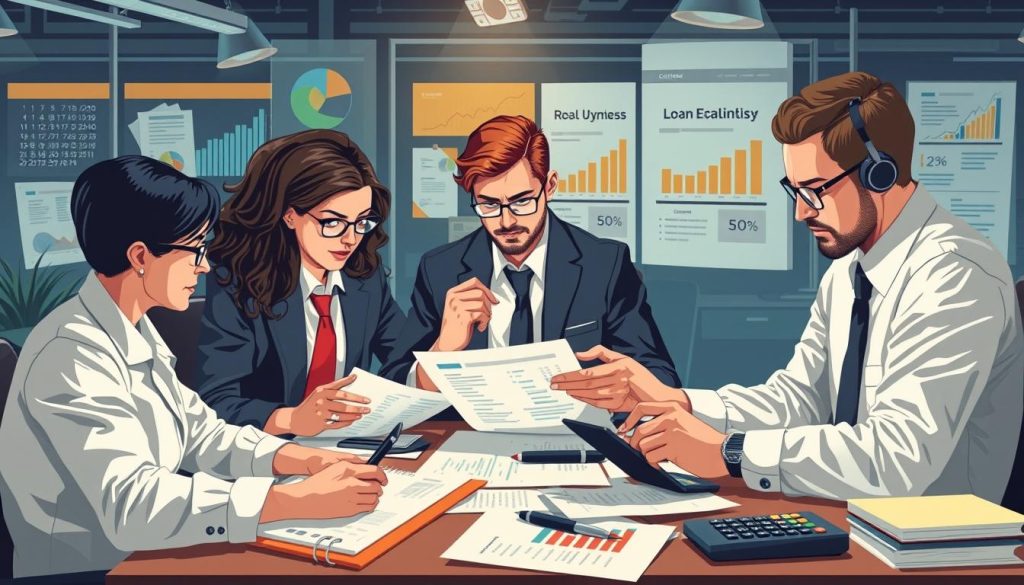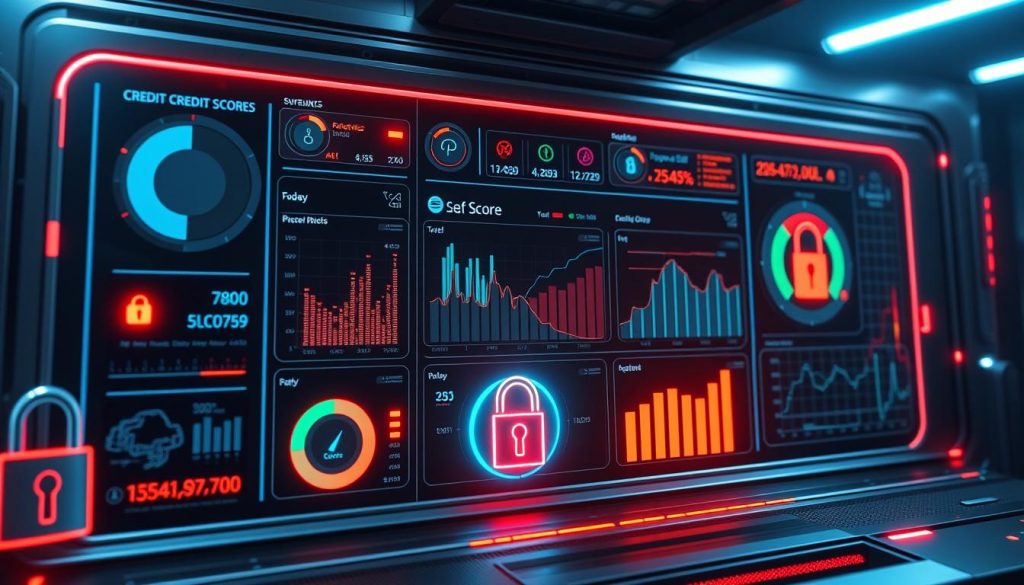Credit assessment is key for lenders to check if people or businesses can pay back loans. It looks at how likely someone is to pay back the loan1. This process helps lenders make smart choices and keep their finances stable.
It uses both numbers and other ways to look at a borrower’s strengths and weaknesses1. For businesses, this check is more detailed than for personal loans1.
New tech is changing how we look at credit, thanks to “Fintechs” using AI and machine learning1. These tools make checking credit faster and safer, and they help make customers happier.
Knowing about credit assessment can lead to many job options in finance1. It’s a big help in the fast-changing world of lending.
Key Takeaways
- Credit assessment is a critical process for lenders to evaluate borrower creditworthiness and minimize credit risk.
- Effective credit assessment involves a comprehensive analysis of a borrower’s character, capacity, capital, collateral, and conditions.
- Commercial lending requires a more complex credit analysis compared to personal lending, with a larger number of quantitative and qualitative data points.
- Fintech innovations, such as AI and machine learning, are disrupting traditional credit analysis techniques and streamlining the credit assessment process.
- Proficiency in credit assessment can lead to diverse career opportunities in the financial services industry.
- https://tunekong.com/indoor-plants-101-the-best-green-companions-for-a-fresh-vibrant-home-14/
Overview of Credit Assessment and Its Importance
Credit assessment is key for financial institutions to check if someone can borrow money. It looks at the borrower’s character, ability, and money. This helps lenders know the risk2. It’s not just about risk; it helps lenders decide on loans, set prices, and manage their credit2.
Definition and Objectives of Credit Assessment
Credit assessment checks if someone is good for a loan2. It looks at credit scores, payment history, debts, and how much credit is used2. Now, some lenders also look at social media and online shopping, plus other data like rent and utility bills2.
The Role of Credit Assessment in Financial Decision-Making
Credit assessment is vital for making smart loan decisions2. It helps set loan prices and manage credit2. The debt markets are huge, and credit analysis helps put money where it can grow3. By checking creditworthiness, lenders can guess default chances and how much they might lose3.
It also helps understand risks that could make loans more expensive and less liquid3. Recovery rates matter too, based on the company’s finances and the economy3. Agencies like Moody’s and Standard & Poor’s give lenders the info they need3.
Key Components of Credit Assessment
Effective credit assessment has three main parts: credit policies and procedures, credit risk assessment, and credit decision-making. These parts work together to make sure credit risk is handled well and lending is done wisely.
Credit Policies and Procedures
Credit policies and procedures set the rules for giving credit. They cover things like credit limits, terms, and how to apply for credit4. Having clear policies helps lenders manage risk and make consistent decisions.
Credit Risk Assessment
The credit risk assessment looks at how likely a borrower is to pay back the loan. It checks their credit score and payment history4. The FICO score, which goes from 300 to 850, and the credit report, which keeps track of borrowing history, are key parts of this process.
Credit Decision Making
When making decisions, lenders look at the borrower’s creditworthiness and how much credit they’re asking for4. They also consider the borrower’s debt-to-income ratio and job stability. This helps them decide if they should lend the money.
Understanding these key parts of credit assessment helps lenders make smart choices. It helps them manage risk and build strong lending relationships5. Using digital tools and data can make the process better, letting credit teams focus on important tasks and make better decisions5.

In short, credit assessment has three main parts: policies, risk assessment, and decision-making. Together, they ensure a strong approach to managing credit risk and supporting responsible lending.
Credit Monitoring and Control
Managing credit well goes beyond just checking credit scores at the start. Credit monitoring and control mean keeping an eye on accounts to spot financial trouble early. This includes handling overdue accounts and using strategies for collections when needed. Keeping a close watch on credit is key to lowering credit risk, improving cash flow, and keeping good customer relations6.
Checking on customer accounts often lets you catch issues like late payments or odd spending early. This lets you fix problems before they get worse. With strong credit control steps, you can handle overdue accounts well and keep cash flow steady7.
For credit risk mitigation, watching and controlling credit is very important. By keeping an eye on how customers behave financially, you can stop risks before they start. This keeps your credit healthy and lowers the chance of defaults or write-offs6.
Many services help you keep track of your customers’ credit health. They offer things like checking credit reports, alerts for fraud, protection against identity theft, and tracking credit scores. Prices for these services can change, with paid ones often giving more detailed checks and coverage than free ones67.
| Credit Monitoring Service | Monthly Cost | Key Features |
|---|---|---|
| Identity Force | $17.95 – $34.95 | Credit monitoring, identity theft protection, $1 million insurance |
| Credit Sesame | $9.95 – $29.95 | Credit monitoring, score tracking, identity theft protection |
| Equifax Complete™ Premier | $19.95 | Credit monitoring, fraud alerts, identity theft insurance |
Using strong credit monitoring and control methods helps manage credit risk, improve cash flow, and keep good customer relations. This proactive way of managing credit is key for financial pros aiming to succeed in today’s fast-paced business world687.

The 5 Cs of Credit Assessment
Financial institutions use the 5 Cs of credit to check if someone is good for a loan. These are character, capacity, capital, collateral, and conditions9. This method helps lenders decide if a borrower is a good risk and if they can pay back the loan9.
Character: Evaluating the Borrower’s Creditworthiness
Lenders look at the borrower’s credit history and reputation to understand their character9. They use scores like the FICO score to see if someone is likely to pay back the loan10.
Capacity: Assessing Repayment Ability
Capacity means how well a borrower can handle their debts. Lenders check financial ratios to see if someone can pay back the loan10. This helps them understand the risk of lending to someone.
Capital: Examining Financial Strength
Capital looks at the borrower’s financial health. Lenders look at assets and how much money is available to cover debts9. This shows if someone can handle financial ups and downs11.
Lenders use the 5 Cs to make smart choices and manage risks9. Knowing and using this method is key for credit teams to lend wisely and protect their money9.
Credit Assessment for Commercial Lending
Assessing credit for commercial lending is much more complex than for personal lending. It involves looking at many numbers and other data to give a business a credit score. This score affects how much the loan will cost and what it will look like12.
Underwriting Commercial Credit
Understanding credit in corporate finance is key. It helps lenders see what makes each business unique and decide if they can lend. Things like the borrower’s trustworthiness, ability to pay back, and financial strength are very important13.
- Character: Checking if the borrower is trustworthy
- Capacity: Seeing if the borrower can pay back the loan
- Capital: Looking at the borrower’s financial strength
Importance of Credit Analysis in Corporate Finance
Assessing commercial credit is crucial for corporate finance. It helps lenders understand business operations and make smart lending choices. By using advanced analytics and automation, lenders can make their credit risk assessment more accurate and efficient. This leads to better lending practices and outcomes for businesses12.
| Key Benefits of Credit Assessment in Commercial Lending | Percentage Impact |
|---|---|
| Reduced margin for human error in credit risk assessment | Significant reduction |
| Enhanced predictability of credit early warning systems | Up to 25% improvement |
| Reduced revenue leakage and cost savings | Up to 10% and 50% respectively |
| Prompt adjustment of assessment criteria to ensure compliance | Immediate adjustment capabilities |
| Facilitation of instant origination of tailored personal loans | At the point of sale |
| Predictive accuracy of late payment identification | 70 to 90% accuracy, 6-9 months in advance |
| Cost savings in SME and commercial banking segments | Up to 50% |
| Increase in client interactions for Relationship Managers | 400% |
The process of assessing commercial credit is key to corporate finance. It helps lenders make smart choices and understand business operations. By using advanced analytics and automation, lenders can make their credit risk assessment more accurate and efficient. This leads to better lending practices and outcomes for businesses1213.
“Gathering good data to support community growth and the financial viability of CDFIs is essential.”
– Ben S. Bernanke, Former Chairman of the Federal Reserve
Nonprofit commercial lenders are crucial for economic and social change. They provide capital for business growth and job creation. These lenders need to show they are financially strong to get the funding they need to keep going and adapt to market changes14.
Credit Assessment: Leveraging Technology and Fintech Innovations
The fintech industry is changing how we assess credit with AI and machine learning. These tools help analyze and underwrite credit more efficiently15. Now, peer-to-peer lending connects borrowers directly with lenders, cutting out middlemen15. Crowdfunding lets ventures raise money by engaging with investors directly15. FinTech’s new credit scoring looks at social media and online behavior, helping more people get credit.
Buy Now, Pay Later (BNPL) services are a big change in credit assessment15. They make buying things easier by letting customers pay in installments15. BNPL helps people manage their money better, attracting those with different financial needs15. It also helps stores by bringing in new customers and boosting sales.
FinTech has made big steps in credit decisions and risk modeling16. It uses new data to give credit to those without a credit history16. Open banking and APIs speed up loan processing and improve risk checks16. AI and machine learning automate and improve credit risk assessments in FinTech.
FinTech is also looking at commercial credit for small businesses17. It can lower credit risk by adapting to market changes and borrower behavior17. By using social media and online shopping data, fintechs understand risk better and help more people.
As fintech grows, technology and new approaches will make credit assessment smoother and more efficient16. Blockchain-based lending cuts out middlemen, lowers fraud, and makes loans more transparent16. RegTech helps lenders check credit risk and follow laws like anti-money laundering and know-your-customer rules.
The future of credit assessment is about combining fintech with data, analytics, and automation for better lending17. Working together in the fintech industry can share insights and improve risk management.
Conclusion
Credit assessment is key to managing money well. It helps reduce credit risk and keep finances stable for both businesses and individuals. Understanding the 5 Cs of credit is vital for making smart financial choices and managing risks18. As finance changes, using new tech and credit assessment methods is important for staying ahead and helping clients19.
Good credit assessment is very important. It affects your financial options, the interest rates you get, and borrowing costs18. A strong credit score means better terms and lower costs, leading to more financial stability and growth18. But a bad credit score means higher interest rates, less credit access, and trouble getting housing or insurance18.
As finance changes, using new credit assessment tech is key. This includes cloud-based platforms and automated workflows19. These tools help financial experts make better decisions and give customers a better experience19. By using these new solutions, you can make smarter financial choices and reach your goals19.
FAQ
What is credit assessment and what are its objectives?
Credit assessment checks if someone can borrow money and pay it back. It looks at their ability, character, and financial resources. The goal is to understand if they can handle the loan.
How does credit assessment play a crucial role in financial decision-making?
It helps lenders decide who to lend to and how much to charge. This process reduces risks, improves cash flow, and keeps finances stable. It also helps build strong relationships with customers.
What are the key components of effective credit assessment?
Good credit assessment has three main parts: credit policies, risk assessment, and decision-making. These help set loan terms, check if someone can borrow, and guide loan decisions.
Why is credit monitoring and control important in credit management?
Credit management is more than just giving loans. It includes keeping an eye on accounts, spotting financial trouble, and handling late payments. This helps reduce risks, manage cash better, and keep customers happy.
What is the 5 Cs of Credit framework and how is it used in credit assessment?
The 5 Cs of Credit is a way to check if someone can borrow money. It looks at their character, income, financial health, and other factors. This helps lenders understand the borrower’s situation better.
How does credit assessment differ between personal and commercial lending?
Commercial lending is more complex than personal lending. It looks at more data and uses a special credit rating. This rating affects the loan’s cost and terms.
How are fintech companies disrupting traditional credit assessment practices?
Fintech uses AI and machine learning to make credit checks faster and smarter. These new tools can process more information quickly, making lending more efficient and accurate.

